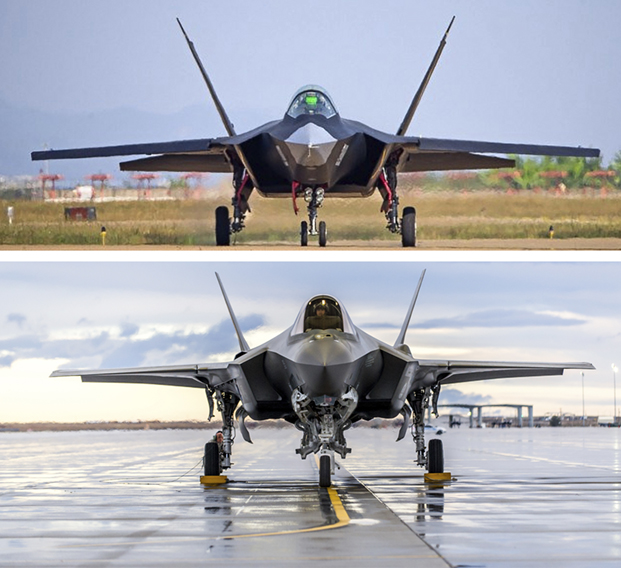
China’s J-31 (top) is an F-35 knockoff, and DOD admits it. ifuun.com and USAF
One of the United States’ undeniable advantages lies in its recurring ability to turn science fiction into reality. American innovators have repeatedly transformed the world with both revolutionary consumer goods and unmatched government-sponsored capabilities. Much of the technology the Air Force has sponsored has underpinned national security for decades.
During the Cold War, the US turned to technology as a way to offset the Soviet Union’s enormous numerical advantages. It was a strategy that paid off handsomely.
Today, the nation is reaping the benefits of many technologies USAF was present for from the beginning. Unmatched stealth aircraft like the F-22 Raptor, the now-ubiquitous Global Positioning System, ever-evolving precision weapons, and remotely piloted aircraft like the MQ-9 Reaper all owe their existence in large measure to Air Force-inspired American ingenuity.
Maj. Gen. William T. Cooley, a mechanical engineer by education and now commander of the Air Force Research Laboratory (AFRL) here, has watched USAF’s science and technology successes and struggles for nearly three decades. New technologies progress too slowly and emergent capabilities frequently stall when it comes time to transition to operational use. These are “enduring problems,” Cooley said in an interview.
But what happens when an enemy—whether by watching the US publicly wage its wars for the past 27 years, or by taking advantage of rapidly advancing commercial technologies, or through a surreptitious hacking campaign—is able copy, steal, or just avoid America’s technological advantages? This is a growing problem.
Many enemies, large and small, have effectively “gone to school” on modern war by carefully observing US operations since 1990. Regarding commercial capabilities, Cooley notes that industrial research and development funding first surpassed government R&D in the 1990s, and the private sector now outspends the government by two-and-a-half times.
Quickly developing the next generation of game-changing capabilities and successfully transitioning them into operational use is more important than ever. It is increasingly difficult to keep the nation’s technological advantages. Some recent examples:
-
Images of China’s J-20 stealth fighter first surfaced in 2010, when then-Defense Secretary Robert M. Gates was visiting the communist state. Gates had previously predicted that Chinese stealth fighters would not appear until 2020.
-
Two years later, China’s J-31 flew for the first time. Top Defense officials say China’s J-20 and J-31 stealth fighters were greatly aided by espionage. Indeed, head-on, a J-31 is almost indistinguishable from a Lockheed Martin F-35. Why start from scratch if you can steal major portions of the plans
-
In 2014, the Justice Department indicted five members of China’s Peoples Liberation Army for “economic offenses directed at … the US nuclear power, metals, and solar products industries,” according to a DOJ release. This was formal acknowledgement China had military hackers targeting the US.
The bottom line is that, in addition to protecting advantages the Air Force already has, USAF must keep the pedal to the metal.
Air Force Secretary Heather Wilson has asked AFRL to “clean the whiteboard,” and take a fresh look at the Air Force’s entire science and technology enterprise, said Cooley. The comprehensive S&T review will run the duration of 2018.
_You can read this story in our print issue:
Overall, AFRL is staffed by outstanding scientists and engineers with “a lot going very well,” he said, but AFRL cannot rest on its laurels.
“Organizations can sometimes get in a rut and not necessarily pay attention to emerging things. Every so often you need to view with new eyes the state of the environment,” Cooley said.
“To be agile enough to maintain our advantage, the Air Force must reach for … game-changing technologies,” stated USAF’s 30-year “A Call to the Future” strategy paper in 2014. Some of the more promising technologies cited were hypersonic speed, nanotechnology (to create lighter and stronger structures), directed energy, and unmanned systems. Three years on, Cooley says AFRL is “continuing to push those [and] make them militarily useful.”
It is ever harder to stay in first place technologically, but with consistent support from DOD and Congress the Air Force is well positioned to do just that. This is never a given, however. As Cooley noted, when funds are tight, programmers will inevitably raid the future to pay for current needs.
Whether it is hypersonic weapons, scalable laser weapons that almost never run out of ammo, autonomous programs that take much of the toil out of intelligence processing (or capabilities too secret to be discussed yet), the race to develop the next generation of war winning capabilities is on—and it has no finish line.